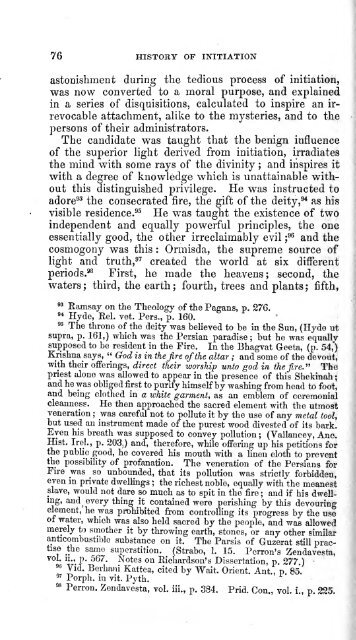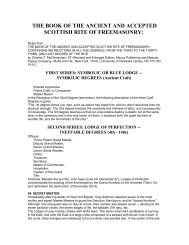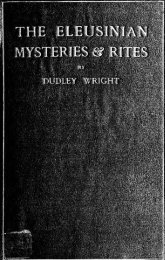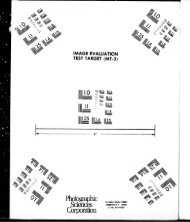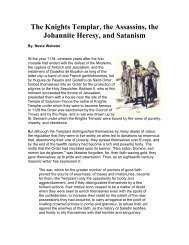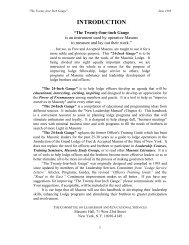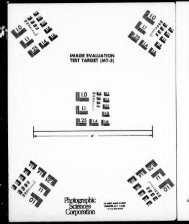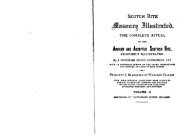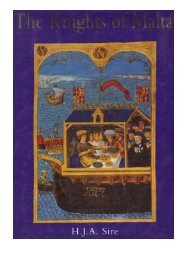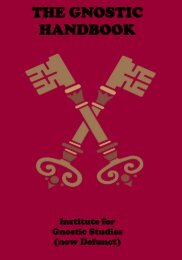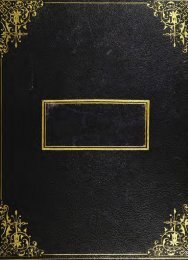The History of Initiation - The Masonic Trowel
The History of Initiation - The Masonic Trowel
The History of Initiation - The Masonic Trowel
Create successful ePaper yourself
Turn your PDF publications into a flip-book with our unique Google optimized e-Paper software.
76 HISTORY OF INITIATION<br />
astonishment during the tedious process <strong>of</strong> initiation,<br />
was now converted to a moral purpose, and explained<br />
in a series <strong>of</strong> disquisitions, calculated to<br />
inspire an irrevocable<br />
attachment, alike to the mysteries, and to the<br />
persons <strong>of</strong> their administrators.<br />
<strong>The</strong> candidate was taught that the benign influence<br />
<strong>of</strong> the superior light derived from initiation, irradiates<br />
the mind with some rays <strong>of</strong> the divinity and ; inspires it<br />
with a degree <strong>of</strong> knowledge which is unattainable without<br />
this distinguished privilege. He was instructed to<br />
adore93 94 the consecrated fire, the gift <strong>of</strong> the deity, as his<br />
visible residence. 95 He was taught the existence <strong>of</strong> two<br />
independent and equally powerful principles,<br />
the one<br />
essentially good, the other irreclaimably evil 9G and the<br />
;<br />
cosmogony was this : Ormisda, the supreme source <strong>of</strong><br />
light and truth, 97 created the world at six different<br />
periods. 98<br />
First, he made the heavens; second, the<br />
waters; third, the earth; fourth, trees and plants; fifth,<br />
93<br />
Kamsay on the <strong>The</strong>ology <strong>of</strong> the Pagans, p. 276.<br />
9*<br />
Hyde, Eel. vet. Pers., p. 160.<br />
J-JLJ VAC, JLliCJL. VOL. _L 01O., J.UU.<br />
JJ.<br />
5 <strong>The</strong> throne <strong>of</strong> the deity was believed to be in the Sun, (Hyde ut<br />
supra, p. 161,) which was the Persian paradise; but he was equally<br />
supposed to be resident in the Fire. In the Bhagvat Geeta, (p. 54,)<br />
Krishna " God is<br />
_says,<br />
in the fire <strong>of</strong> the altar ; and some <strong>of</strong> the devout,<br />
with their<br />
<strong>of</strong>ferings, direct their worship unto god in the<br />
fire." <strong>The</strong><br />
priest alone was allowed to appear in the presence <strong>of</strong> this Shekinah ;<br />
and he was obliged first to purify himself by washing from head to foot,<br />
and being clothed in a white garment, as an emblem <strong>of</strong> ceremonial<br />
cleanness. He then approached the sacred element with the utmost<br />
veneration ; was careful not to pollute it by the use <strong>of</strong> any metal tool,<br />
but used an instrument made <strong>of</strong> the purest wood divested <strong>of</strong> its bark.<br />
Even his breath was supposed to convey pollution ; (Vallancey, Anc.<br />
Hist. IreL, p. 203,) and, therefore, while <strong>of</strong>fering up his petitions for<br />
the public good, he covered his mouth with a linen cloth to prevent<br />
the<br />
possibility <strong>of</strong> pr<strong>of</strong>anation. <strong>The</strong> veneration <strong>of</strong> the Persians for<br />
Fire was<br />
^so unbounded, that its pollution was strictly forbidden,<br />
even in private dwellings ; the richest noble, equally with the meanest<br />
slave, would not dare so much as to spit in the fire and ; if his dwell-<br />
ing, aud ( every thing it contained were perishing by this devouring<br />
element/ he was prohibited from controlling its progress by the use<br />
<strong>of</strong> water, which was also held sacred by the people, and was allowed<br />
merely to smother it by throwing earth, stones, or any other similar<br />
anticombustible substance on it. <strong>The</strong> Parsis <strong>of</strong> Guzerat still practise<br />
the same superstition. (Strabo, 1. 15. Perron's Zendavcsta,<br />
vol. 11., p. 567. Notes on Richardson's Dissertation, p. 277 )<br />
Vid. Berhani Kattea, cited by Wait. Orient. Ant , p 85.<br />
te<br />
Porph. in vit. Pyth.<br />
Perron. Zendavesta, vol. iii., p. 384. Prid. Con., vol. i., p. 225.


